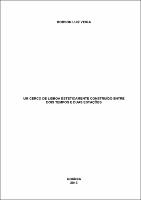| Compartilhamento |


|
Use este identificador para citar ou linkar para este item:
http://tede2.pucgoias.edu.br:8080/handle/tede/3201Registro completo de metadados
| Campo DC | Valor | Idioma |
|---|---|---|
| dc.creator | Veiga, Robson Luiz | - |
| dc.creator.Lattes | http://lattes.cnpq.br/8846844073889076 | por |
| dc.contributor.advisor1 | Rodrigues, Maria Aparecida | - |
| dc.contributor.advisor1Lattes | Maria Aparecida Rodrigues | por |
| dc.contributor.referee1 | Ventura, Susana Ramos | - |
| dc.contributor.referee1Lattes | http://lattes.cnpq.br/3828608150600836 | por |
| dc.contributor.referee2 | Nascimento, Maria Teresinha Martins do | - |
| dc.contributor.referee2Lattes | http://lattes.cnpq.br/8206433968369762 | por |
| dc.date.accessioned | 2016-08-10T11:06:58Z | - |
| dc.date.available | 2014-05-16 | - |
| dc.date.issued | 2013-11-26 | - |
| dc.identifier.citation | VEIGA, Robson Luiz. UM CERCO DE LISBOA ESTETICAMENTE CONSTRUÍDO ENTRE DOIS TEMPOS E DUAS ESTAÇÕES.. 2013. 106 f. Dissertação (Mestrado em Ciências Humanas) - Pontifícia Universidade Católica de Goiás, GOIÂNIA, 2013. | por |
| dc.identifier.uri | http://localhost:8080/tede/handle/tede/3201 | - |
| dc.description.resumo | Este trabalho tem por objetivo apresentar uma análise literária do romance História do cerco de Lisboa do escritor português José Saramago, publicado em 1989, apresentando-o como uma metaficção historiográfica, termo cunhado pela crítica canadense Linda Hutcheon, após diferenciar as produções contemporâneas em relação ao romance histórico tradicional, este, proposto pelo húngaro Georg Lukacs. Além desta proposição, será tratado neste trabalho o dialogismo que permeia esta escritura, seja o cruzamento entre textos em forma de intertextualidade, tendo por referência a crítica de Julia Kristeva, esta, como leitora do teórico russo Mikhail Bakhtin; seja pelo diálogo interlocutivo, na qual o leitor, ao acompanhar o trabalho estético, convive seus olhares entre dois tempos, cuja fundamentação é atravessada pelos pressupostos dos teóricos pertinentes à Escola de Constança, Hans Robert Jauss e Wolfgang Iser. Por último, ao analisar os limiares entre o discurso histórico em cruzamento com o discurso literário, a fundamentação será baseada de acordo as postulações dos historiadores da Nova História, cuja semelhança é retratada na obra pela voz do personagem protagonista, o revisor Raimundo Benvindo Silva, sobretudo, em relação ao seu discurso crítico que encara a historiografia, como literatura, principalmente por ser narrativa e construída em forma de textos. | por |
| dc.description.abstract | This paper aims to present a literary analysis of the novel History of the Siege of Lisbon the Portuguese writer José Saramago, published in 1989, describing it as a historiographic metafiction, a term coined by critics Canadian Linda Hutcheon, after differentiating the contemporary productions in relation to traditional historical novel, this proposed by the Hungarian Georg Lukacs. Besides this proposition, will be treated in this work dialogism that permeates this writing, is the intersection between texts in the form of intertextuality, with reference to the criticism of Julia Kristeva, this, as a reader of the Russian theorist Mikhail Bakhtin; is the intersection between texts in the form of intertextuality, with reference to the criticism of Julia Kristeva, this, as a reader of the Russian theorist Mikhail Bakhtin, dialogue is at interlocutory, in which the reader to follow the aesthetic work, their gazes between two lives time, whose foundation is crossed by the relevant theoretical assumptions to School Constance, Hans Robert Jauss and Wolfgang Iser. Finally, to analyze the thresholds between the historical discourse crossed with literary discourse, the reasons will be based according the postulations of historians of New History, whose likeness is portrayed in the work by the voice of the main character, the reviewer Welcome Raimundo Silva, especially in relation to its critical discourse that sees history as literature, mostly narrative and be built in the form of texts. | eng |
| dc.description.provenance | Made available in DSpace on 2016-08-10T11:06:58Z (GMT). No. of bitstreams: 1 ROBSON LUIZ VEIGA.pdf: 1026452 bytes, checksum: 41fede32f75ddf03d70a245d214b33be (MD5) Previous issue date: 2013-11-26 | eng |
| dc.format | application/pdf | por |
| dc.thumbnail.url | http://localhost:8080/tede/retrieve/9479/ROBSON%20LUIZ%20VEIGA.pdf.jpg | * |
| dc.language | por | por |
| dc.publisher | Pontifícia Universidade Católica de Goiás | por |
| dc.publisher.department | Ciências Humanas | por |
| dc.publisher.country | BR | por |
| dc.publisher.initials | PUC Goiás | por |
| dc.publisher.program | Literatura e Crítica Literária | por |
| dc.rights | Acesso Aberto | por |
| dc.subject | Metaficção Historiográfica | por |
| dc.subject | José Saramago | por |
| dc.subject | História do Cerco de Lisboa | por |
| dc.subject | Dialogismo | por |
| dc.subject | Intertextualidade | por |
| dc.subject | Nova História | por |
| dc.subject | Estética da Recepção | por |
| dc.subject | reception | eng |
| dc.subject | effect | eng |
| dc.subject | aesthetics | eng |
| dc.subject | reader | eng |
| dc.subject | text | eng |
| dc.subject.cnpq | CNPQ::LINGUISTICA, LETRAS E ARTES::LETRAS | por |
| dc.title | UM CERCO DE LISBOA ESTETICAMENTE CONSTRUÍDO ENTRE DOIS TEMPOS E DUAS ESTAÇÕES. | por |
| dc.type | Dissertação | por |
| Aparece nas coleções: | Mestrado em Letras | |
Arquivos associados a este item:
| Arquivo | Descrição | Tamanho | Formato | |
|---|---|---|---|---|
| ROBSON LUIZ VEIGA.pdf | 1 MB | Adobe PDF |  Baixar/Abrir Pré-Visualizar |
Os itens no repositório estão protegidos por copyright, com todos os direitos reservados, salvo quando é indicado o contrário.




